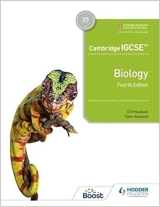Chapter 3. Energy from respiration
Page 20
1. a energy
b Respiration takes place in all the living cells of an organism.
2. a Aerobic respiration needs oxygen; anaerobic respiration does not. Anaerobic respiration
does not completely oxidise the substance it acts on. Anaerobic respiration produces less
energy than aerobic respiration
b 2830 - 118 = 2712 kJ
3. a A food substance and oxygen.
b enzymes.
c carbon dioxide and water.
4. Respiration is a chemical process in all living cells. Resuscitation restores the process of breathing.
5. You need more oxygen to oxidise the lactic acid that has accumulated during vigorous exercise. An increased heart rate delivers the oxygen more rapidly.
6. The 2400 kJ used in 8 hours sleep represents basal metabolism.
Page 24
1. a True (of most organisms)
b The organism is more likely to be producing heat
c True
d True in most cases (some micro-organisms may use only anaerobic respiration)
e No. Respiration results in a loss of weight.
f Movement cannot occur without reapiration but respiration does not necessarily result in movement e.g. the Plant Kingdom.
2. The purpose of the soda lime is to absorb carbon dioxide so that any volume change can be attributed to uptake of oxygen. The lime water is used to detect the presence of carbon dioxide.
3. a In the absence of soda lime there will be a 2cm3 increase in volume.
b If soda lime is present there will be a decrease in volume of 5cm3.
4. In a beaker, the heat generated will be lost to the atmosphere. In a vacuum flask the heat is
retained.
5. The boiled wheat will be dead and should not produce carbon dioxide. If carbon dioxide appears, either it comes from something else, e.g. bacteria or the experiment is invalid.
Page 25
1. In the first experiment, the water was boiled to drive out all the dissolved oxygen and the liquid paraffin prevented any further oxygen dissolving in the water. Therefore production of carbon dioxide must have been from an anaerobic reaction. In the second experiment, the
presence of oxygen did not affect the anaerobic reaction but it would have been impossible to decide whether the respiration was aerobic or anaerobic.
2. d
3. In aerobic respiration, the oxidation of carbon in C6H12O6 produces carbon dioxide and releases energy. In a similar way the sulphur bacteria could be oxidising H2S to produce H2SO4 with a corresponding release of energy. The hypothesis could be tested by excluding oxygen from the bacteria. There should be no production of H2SO4.
4. a (i) 64.3 x 134 = 8616.2 kJ
(ii) 0.018 x 2736 = 49.3 kJ
b The mouse
c The body temperatures of these animals are very similar. Therefore you would not expect the energy expenditure to make up for heat loss per m2 to be very different. |
Downloads
Download the answers in PDF format below
Section 1, Chapters 1-5
Section 2, Chapters 6-9
Section 3, Chapters 10-12
Section 3, Chapters 13-17
Section 3, Chapters 18-20
Section 4, Chapters 21-24
Section 5, Chapters 25-27
Section 5, Chapters 28-29
Section 6, Chapters 30-34
Section 6, Chapters 35-37
Section 7, Chapters 38-39
Section 8, Chapters 40-41
|
